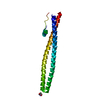[English] 日本語
 Yorodumi
Yorodumi- PDB-7o3y: Structural basis for VIPP1 oligomerization and maintenance of thy... -
+ Open data
Open data
- Basic information
Basic information
| Entry | Database: PDB / ID: 7o3y | ||||||||||||||||||||||||
|---|---|---|---|---|---|---|---|---|---|---|---|---|---|---|---|---|---|---|---|---|---|---|---|---|---|
| Title | Structural basis for VIPP1 oligomerization and maintenance of thylakoid membrane integrity | ||||||||||||||||||||||||
 Components Components | Protein sll0617 | ||||||||||||||||||||||||
 Keywords Keywords | LIPID BINDING PROTEIN /  ESCRT-III / Membrane remodelling / nucleotide hydrolysis / ESCRT-III / Membrane remodelling / nucleotide hydrolysis /  photosynthesis / thylakoid biogenesis / photosynthesis / thylakoid biogenesis /  stress response stress response | ||||||||||||||||||||||||
| Function / homology | PspA/IM30 / PspA/IM30 family /  plasma membrane / ADENOSINE-5'-DIPHOSPHATE / Membrane-associated protein Vipp1 plasma membrane / ADENOSINE-5'-DIPHOSPHATE / Membrane-associated protein Vipp1 Function and homology information Function and homology information | ||||||||||||||||||||||||
| Biological species |  | ||||||||||||||||||||||||
| Method |  ELECTRON MICROSCOPY / ELECTRON MICROSCOPY /  single particle reconstruction / single particle reconstruction /  cryo EM / Resolution: 3.8 Å cryo EM / Resolution: 3.8 Å | ||||||||||||||||||||||||
 Authors Authors | Gupta, T.K. / Klumpe, S. / Gries, K. / Strauss, M. / Rudack, T. / Schuller, J.M. / Schroda, M. / Engel, B.D. | ||||||||||||||||||||||||
| Funding support |  Germany, Germany,  Japan, 7items Japan, 7items
| ||||||||||||||||||||||||
 Citation Citation |  Journal: Cell / Year: 2021 Journal: Cell / Year: 2021Title: Structural basis for VIPP1 oligomerization and maintenance of thylakoid membrane integrity. Authors: Tilak Kumar Gupta / Sven Klumpe / Karin Gries / Steffen Heinz / Wojciech Wietrzynski / Norikazu Ohnishi / Justus Niemeyer / Benjamin Spaniol / Miroslava Schaffer / Anna Rast / Matthias ...Authors: Tilak Kumar Gupta / Sven Klumpe / Karin Gries / Steffen Heinz / Wojciech Wietrzynski / Norikazu Ohnishi / Justus Niemeyer / Benjamin Spaniol / Miroslava Schaffer / Anna Rast / Matthias Ostermeier / Mike Strauss / Jürgen M Plitzko / Wolfgang Baumeister / Till Rudack / Wataru Sakamoto / Jörg Nickelsen / Jan M Schuller / Michael Schroda / Benjamin D Engel /    Abstract: Vesicle-inducing protein in plastids 1 (VIPP1) is essential for the biogenesis and maintenance of thylakoid membranes, which transform light into life. However, it is unknown how VIPP1 performs its ...Vesicle-inducing protein in plastids 1 (VIPP1) is essential for the biogenesis and maintenance of thylakoid membranes, which transform light into life. However, it is unknown how VIPP1 performs its vital membrane-remodeling functions. Here, we use cryo-electron microscopy to determine structures of cyanobacterial VIPP1 rings, revealing how VIPP1 monomers flex and interweave to form basket-like assemblies of different symmetries. Three VIPP1 monomers together coordinate a non-canonical nucleotide binding pocket on one end of the ring. Inside the ring's lumen, amphipathic helices from each monomer align to form large hydrophobic columns, enabling VIPP1 to bind and curve membranes. In vivo mutations in these hydrophobic surfaces cause extreme thylakoid swelling under high light, indicating an essential role of VIPP1 lipid binding in resisting stress-induced damage. Using cryo-correlative light and electron microscopy (cryo-CLEM), we observe oligomeric VIPP1 coats encapsulating membrane tubules within the Chlamydomonas chloroplast. Our work provides a structural foundation for understanding how VIPP1 directs thylakoid biogenesis and maintenance. | ||||||||||||||||||||||||
| History |
|
- Structure visualization
Structure visualization
| Movie |
 Movie viewer Movie viewer |
|---|---|
| Structure viewer | Molecule:  Molmil Molmil Jmol/JSmol Jmol/JSmol |
- Downloads & links
Downloads & links
- Download
Download
| PDBx/mmCIF format |  7o3y.cif.gz 7o3y.cif.gz | 216.8 KB | Display |  PDBx/mmCIF format PDBx/mmCIF format |
|---|---|---|---|---|
| PDB format |  pdb7o3y.ent.gz pdb7o3y.ent.gz | 176.2 KB | Display |  PDB format PDB format |
| PDBx/mmJSON format |  7o3y.json.gz 7o3y.json.gz | Tree view |  PDBx/mmJSON format PDBx/mmJSON format | |
| Others |  Other downloads Other downloads |
-Validation report
| Arichive directory |  https://data.pdbj.org/pub/pdb/validation_reports/o3/7o3y https://data.pdbj.org/pub/pdb/validation_reports/o3/7o3y ftp://data.pdbj.org/pub/pdb/validation_reports/o3/7o3y ftp://data.pdbj.org/pub/pdb/validation_reports/o3/7o3y | HTTPS FTP |
|---|
-Related structure data
| Related structure data |  12712MC  7o3wC  7o3xC  7o3zC  7o40C M: map data used to model this data C: citing same article ( |
|---|---|
| Similar structure data | |
| EM raw data |  EMPIAR-10680 (Title: Structural basis for VIPP1 oligomerization and maintenance of thylakoid membrane integrity EMPIAR-10680 (Title: Structural basis for VIPP1 oligomerization and maintenance of thylakoid membrane integrityData size: 2.0 TB Data #1: Unaligned frames of VIPP1 from K2 operated in counting mode [micrographs - multiframe]) |
- Links
Links
- Assembly
Assembly
| Deposited unit | 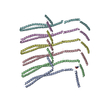
|
|---|---|
| 1 | x 16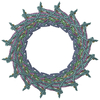
|
- Components
Components
| #1: Protein | Mass: 28822.145 Da / Num. of mol.: 6 Source method: isolated from a genetically manipulated source Source: (gene. exp.)  Strain: PCC 6803 / Kazusa / Gene: sll0617 / Production host:   Escherichia coli (E. coli) / Strain (production host): ER2566 / References: UniProt: Q55707 Escherichia coli (E. coli) / Strain (production host): ER2566 / References: UniProt: Q55707#2: Chemical | ChemComp-ADP / |  Adenosine diphosphate Adenosine diphosphateHas ligand of interest | Y | |
|---|
-Experimental details
-Experiment
| Experiment | Method:  ELECTRON MICROSCOPY ELECTRON MICROSCOPY |
|---|---|
| EM experiment | Aggregation state: PARTICLE / 3D reconstruction method:  single particle reconstruction single particle reconstruction |
- Sample preparation
Sample preparation
| Component | Name: VIPP1 / IM30 complex / Type: COMPLEX / Entity ID: #1 / Source: RECOMBINANT |
|---|---|
| Molecular weight | Experimental value: NO |
| Source (natural) | Organism:  |
| Source (recombinant) | Organism:   Escherichia coli (E. coli) / Strain: ER2566 Escherichia coli (E. coli) / Strain: ER2566 |
| Buffer solution | pH: 7.5 |
| Specimen | Embedding applied: NO / Shadowing applied: NO / Staining applied : NO / Vitrification applied : NO / Vitrification applied : YES : YES |
| Specimen support | Grid material: COPPER / Grid type: Quantifoil R2/1 |
Vitrification | Cryogen name: ETHANE-PROPANE |
- Electron microscopy imaging
Electron microscopy imaging
| Experimental equipment |  Model: Titan Krios / Image courtesy: FEI Company |
|---|---|
| Microscopy | Model: FEI TITAN KRIOS |
| Electron gun | Electron source : :  FIELD EMISSION GUN / Accelerating voltage: 300 kV / Illumination mode: FLOOD BEAM FIELD EMISSION GUN / Accelerating voltage: 300 kV / Illumination mode: FLOOD BEAM |
| Electron lens | Mode: BRIGHT FIELD Bright-field microscopy / Cs Bright-field microscopy / Cs : 2.7 mm : 2.7 mm |
| Specimen holder | Cryogen: NITROGEN / Specimen holder model: FEI TITAN KRIOS AUTOGRID HOLDER |
| Image recording | Electron dose: 45 e/Å2 / Detector mode: COUNTING / Film or detector model: GATAN K2 SUMMIT (4k x 4k) |
- Processing
Processing
| EM software |
| ||||||||||||||||||||||||||||||||||||
|---|---|---|---|---|---|---|---|---|---|---|---|---|---|---|---|---|---|---|---|---|---|---|---|---|---|---|---|---|---|---|---|---|---|---|---|---|---|
CTF correction | Type: PHASE FLIPPING AND AMPLITUDE CORRECTION | ||||||||||||||||||||||||||||||||||||
3D reconstruction | Resolution: 3.8 Å / Resolution method: FSC 0.143 CUT-OFF / Num. of particles: 48000 / Symmetry type: POINT | ||||||||||||||||||||||||||||||||||||
| Atomic model building | Protocol: FLEXIBLE FIT / Space: REAL Details: Initial model 4whe used for comparative modelling and Rosetta to predict the missing segments | ||||||||||||||||||||||||||||||||||||
| Atomic model building | PDB-ID: 4WHE Pdb chain-ID: A |
 Movie
Movie Controller
Controller













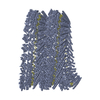

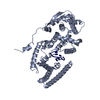
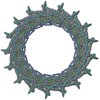
 PDBj
PDBj

